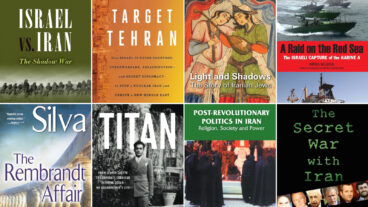The Ramallah town gathering – ‘It is the first time someone is asking Palestinians what they really think.'”Each one of us needs to understand our power and our responsibility and take action by asking: What am I willing to do to end the conflict?” That statement was made in a video clip featuring young Palestinian and Israelis, presented at the World Economic Conference in Davos, Switzerland last week.
The video presentation, which was aired via closed circuit to a conference room filled with hundreds of the world’s most influential leaders, was the kickoff of the grassroots organization One Voice’s $5 million “What are you Willing to do to End the Conflict?” campaign. Among those present for the screening were Klaus Schwab, Founder and Executive Chairman of The World Economic Forum, Israel’s Vice Premier Shimon Peres, Palestinian Authority President Mahmoud Abbas and Israel’s Foreign Minister Tzippi Livni.
The short broadcast showed images of One Voice efforts to kick-start a Palestinian-Israeli dialogue and root out extremism: town hall meetings in Israel and the West Bank, leaflet dissemination, petition signing, rallies, marches and interviews with moderates on all sides. One Voice, founded by American Daniel Lubetzky in 2002, advocates amplifying and empowering the voices of moderate Israelis and Palestinians while quelling extremist factions. The organization boasts a 250,000-strong membership.
“If we’re going to end this conflict,” former US Middle East envoy Dennis Ross conveyed in the video clip, “we need to address matters from the grassroots on up.”
Grassroots voices included Chrissy Soudain of Jerusalem: “One Voice enables the Israeli and Palestinian people to take steps to propel political representatives towards a comprehensive political agreement.”
“We still haven’t won the war for peace,” noted Miri Olifant of Tel Aviv. “But we will not stop engaging through non-violent action until we prevail,” concluded Odeh Awwad of Bir Zeit University.
“It is the first time someone is asking Palestinians what they really think,” said an unidentified Palestinian man in the clip.
The clip ended with two kindergarten-aged children asking in Arabic and Hebrew: “What are we willing to do to end the conflict?”
Messages from town hall meetings in Tel Aviv, Ramallah and Jerusalem were then broadcast to attendees from One Voice directors and leaders stationed in each of the three cities.
“People in the audience – made up of extremely influential people – were teary-eyed. Tens of thousands of people have seen the video and millions have seen reports about the gathering – and all of those felt a much needed ray of hope.” Lubetzky told ISRAEL21c from Davos following the summit.
After the screening, Abbas, Livni and Peres took turns at the dais expressing their reactions to the clip and voicing plans for the future. While Abbas and Livni launched into lengthy political addresses, they began by expressing hope and willingness for arriving at a peaceful solution. In her speech, Livni reiterated the need for a two-state solution and expressed commitment to the overall process.
“We all watched it with mixed feelings,” Livni told the audience in Davos. “Sadness for lost opportunities but on the other hand, hope. They gave me hope but I think our responsibility is to give them hope. They are our children and our future. If there is something to come out of this room, it is a promise to generations to come to bring peace to our region.”
Mahmoud Abbas reiterated the need for dialogue on a personal level, saying the presentation had also “instilled hope” in his heart. “In the past century we have lived side by side but we didn’t have the people to people relationship. We have reached that step now belatedly. Dialogue between sectors of society will lead to peace.”
Shimon Peres stressed the connection between politics and economy, telling attendees in a straightforward manner the two are inseparable. “The better the Palestinians have it, the better we will have it. That’s the best thing we can do for ourselves. Fatah represents the future; Hamas the past,” he said referring to the moderate and extremist factions within the current Palestinian political realm.
In Ramallah, One Voice Palestine Executive Director Nisreen Shaheen – who watched the historical broadcast with dozens of like-minded Palestinians – expressed cautious optimism.
“For us as One Voice Palestine and Palestinians in general, it was an exciting moment to see the people’s voice being heard by important world decision makers. But we felt like leaders listened to the voices in the video and then went back to their top level political agendas and rhetoric,” Shaheen told ISRAEL21c. “But for us, it gave us a feeling that now there is a bigger responsibility and more effort to be dedicated.”
And in Tel Aviv, Israel’s One Voice Executive Director Gil Shami said that although appearances would suggest otherwise, he believes One Voice represents a majority in favor of ousting extremism.
“Many people ask me how it can be that the Hamas is in power; I’m saying Hamas is a metaphor for desperation. When the Oslo agreement was signed, 88% of Palestinians supported it,” Shami said. “They lost hope and the answer to desperation was Hamas. We saw with Lebanon this summer that missiles can hit Israeli cities. The situation requires urgency because desperation leads to catastrophe.”
Lubetzky, summed up the organization’s efforts and results: “We’ve been building this human infrastructure for five years, and, in spite of the horrible atmosphere, or perhaps because of it, we are gaining more members and more momentum. People are ready to stand up and say, ‘Enough!'”












